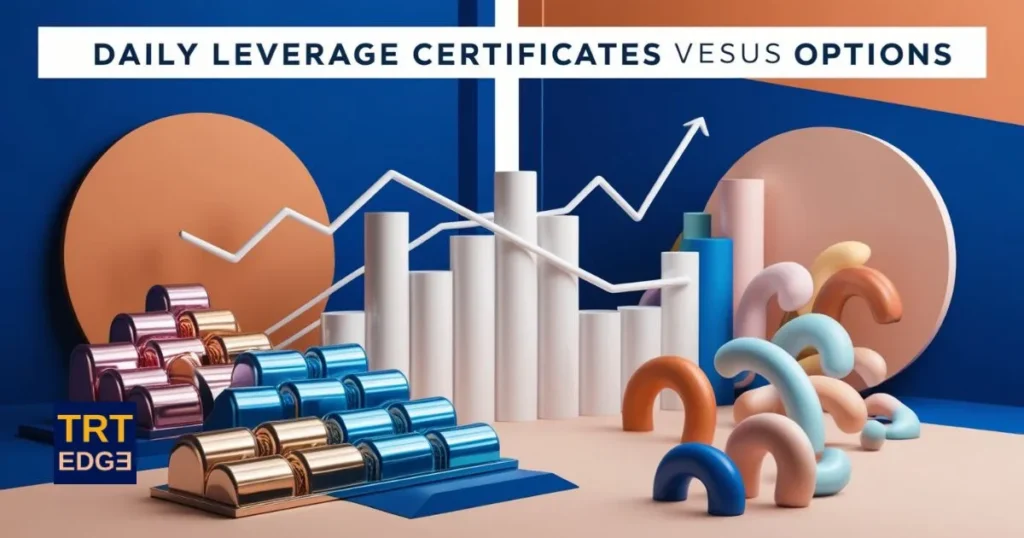Daily Leverage Certificates (DLCs) vs Options: The Showdown!

Introduction to Daily Leverage Certificates (DLCs) vs Options
Societe Generale has introduced a new series of US Stock Daily Leverage Certificates (DLCs) on the Singapore Exchange (SGX), focused on the “Magnificent Seven” companies (Apple, Amazon, Alphabet, Meta, Microsoft, Nvidia, and Tesla). This launch makes Societe Generale the first issuer in Asia to provide investors with a leveraged long-short instrument, allowing them to gain exposure to these US stocks during Asian trading hours.
This means that traders can now trade the “Magnificent Seven” companies using DLCs and options.
When it comes to leveraged trading, both DLCs and options have become popular tools for active traders looking to magnify their returns. While both offer opportunities for significant gains, they come with their own unique risks and characteristics. In this blog, we’ll explore how DLCs work, compare them to options, and determine whether DLCs are worth considering for your trading strategy.
How Do DLCs Work?
Daily Leverage Certificates (DLCs) are financial instruments designed to provide traders with magnified returns based on the performance of an underlying asset, such as stocks, indices, or commodities. DLCs are leveraged products, meaning that they offer a fixed multiple of the underlying asset’s daily return—usually ranging from 3x to 7x.
For example, if you purchase a 5x DLC on the S&P 500 index and the index rises by 1% during the trading day, your DLC would theoretically increase by 5%. Conversely, if the index drops by 1%, your DLC would lose 5%. Unlike options, which have expiration dates and involve the right to buy or sell an asset at a specific price, DLCs are structured to offer daily exposure without the need for time decay considerations.
DLCs come in two forms:
- Long DLCs: For traders expecting the price of the underlying asset to rise.
- Short DLCs: For traders who anticipate a fall in the underlying asset.
Key Features of DLCs:
- Fixed Leverage: DLCs provide consistent leverage (e.g., 5x or 7x) throughout the day.
- Daily Reset: The performance is reset at the end of each trading day, meaning the leverage applies only to the daily movements, not the cumulative performance of the underlying asset over time.
- No Margin Calls: Unlike margin trading, you won’t face margin calls since DLCs are fully collateralized.

Are DLCs Worth It?
The appeal of DLCs lies in their simplicity and transparency. However, before diving into them, it’s crucial to weigh the pros and cons.
Pros of DLCs
- Leverage Without Borrowing: DLCs offer leveraged returns without requiring you to borrow funds or face margin calls.
- Daily Reset Reduces Risk: Since leverage applies only to daily returns, your losses are contained within that day’s movement. You won’t be wiped out by a cumulative downturn over several days.
- Clear Pricing Structure: Unlike options, DLC pricing is easy to understand, as it’s directly linked to the daily performance of the underlying asset.
Cons of DLCs
- Risk of Volatility Drag: The daily reset feature can work against you in volatile markets. If the underlying asset sees large swings, your DLC may lose value even if the asset returns to its original price level. This is known as the “volatility drag.”
- Short-Term Focus: DLCs are designed for short-term trading, meaning they aren’t suitable for buy-and-hold investors. If you hold a DLC over a longer period, daily resets and market volatility can erode its value.
- Limited Flexibility: Compared to options, DLCs offer less flexibility. With options, traders can develop complex strategies, hedge positions, or take advantage of different expiration dates. DLCs, on the other hand, provide straightforward leveraged exposure.
Comparing DLCs to Options
Both DLCs and options can amplify returns, but they do so in fundamentally different ways.
- Options give traders the right, but not the obligation, to buy (call option) or sell (put option) an asset at a predetermined price before a certain date. The payoff depends on the price movement of the underlying asset and time to expiration, adding another layer of complexity.
- DLCs, in contrast, focus on delivering fixed leverage without the expiration or time decay concerns that are inherent to options.
When to Use DLCs
- If you’re looking for simple leverage on short-term trades without having to worry about complex pricing factors or margin calls, DLCs may be a better fit.
When to Use Options
- If you’re more interested in strategic flexibility and the ability to hedge risk, options are generally more versatile.

Conclusion
DLCs can be a great tool for active, short-term traders who understand how leverage works and are looking for exposure to specific assets. However, they aren’t suitable for everyone, especially long-term investors or those unfamiliar with the risks of leveraged products. The key to success with DLCs is proper risk management and a strong understanding of how market volatility impacts leveraged returns.
For traders comfortable with short-term trading and leveraging the power of compounding daily returns, DLCs can be a useful instrument. But for more nuanced strategies, options offer the flexibility and range of opportunities that DLCs may not provide.
In summary, DLCs and options both offer leverage, but their use cases differ significantly. Choose the one that best fits your trading style, risk tolerance, and investment horizon!
Are you ready to discover your trading style, risk tolerance and investment horizon? Contact us for a trade-to-learn experience!

